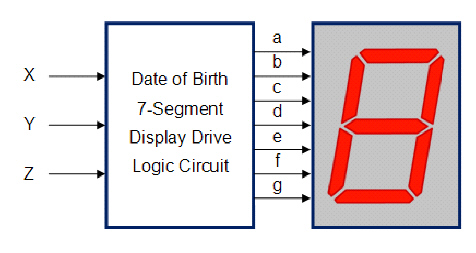In a digital electronics
class of 20, there is a 6.8% probability that two of you share the same date of birth. This is
assuming that you are all the same year level (sophomore). If you are not, the probability would be
even lower.
Your date of birth makes you unique. We are going to use this uniqueness to
design a circuit that will display your date of birth on a single seven-segment display. Admittedly,
this design does not have any real practical application, but is a fun exercise that will bring
together all of the design techniques that you have learned in this lesson.
Your date of birth
may make you unique in your class, but in 2006 there were 263,898,574,096 births world-wide. This
means that on a daily basis, over 700,000,000 individuals share the same date of
birth.
Design
1. Design a combinational logic circuit that has three
inputs and seven outputs. As the inputs (X, Y, and Z) count from 000 to 111, the seven outputs (a)
thru (g) will generate the logic required to display your date of birth on a seven-segment display.
The date of birth will be displayed in the MM-DD-YY format. For example if you were born on May 12,
1993, your design will display 05-12-93.

2. Detail Design
Specification:
· The
seven-segment display must be a common cathode.
· Current limiting resistors (150 W - 270W) must be used.
· The Karnaugh mapping technique must be used
to obtain the simplified logic expression for each of the seven segments.
· At least two segments must be implemented
with NAND only logic.
· At least two
segments must be implemented with NOR only logic.
· The implementation of the remaining
segments is left to your discretion.
Using the
Multisim, enter and test your Date of Birth design. Use switches for the inputs X, Y, & Z. Verify
that the circuit is working as designed. If the circuit is not working properly, review your design
work and circuit implementation to identify your mistake. Make any necessary corrections and retest.
Lastly, breadboard your circuit and show me your working breadboarded circuit.